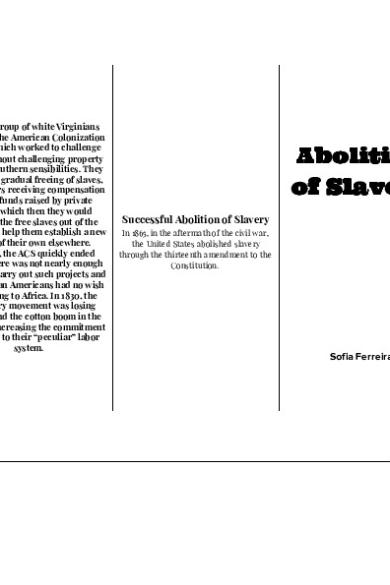APUSH Abolition of Slavery Brochure PDF

| Title | APUSH Abolition of Slavery Brochure |
|---|---|
| Author | Sofia F |
| Course | U.S. History to 1865 |
| Institution | University of Delaware |
| Pages | 4 |
| File Size | 126.2 KB |
| File Type | |
| Total Downloads | 13 |
| Total Views | 168 |
Summary
APUSH Abolition of Slavery Brochure...
Description
In 1817, a group of white Virginians organized the American Colonization Society, which worked to challenge slavery without challenging property rights or southern sensibilities. They proposed a gradual freeing of slaves, with masters receiving compensation through funds raised by private charity, which then they would transport the free slaves out of the country and help them establish a new society of their own elsewhere. However, the ACS quickly ended because there was not nearly enough funding to carry out such projects and many African Americans had no wish in returning to Africa. In 1830, the antislavery movement was losing strength and the cotton boom in the south was increasing the commitment of planters to their “peculiar” labor system.
Abolition of Slavery
Successful Abolition of Slavery In 1865, in the aftermath of the civil war, the United States abolished slavery through the thirteenth amendment to the Constitution.
Sofia Ferreira
Opponents of the Reform
Leaders of the Reform ❖
❖
❖
❖
❖
William Lloyd Garrison founded his own weekly newspaper known as “The Liberator”. He said that opponents of slavery should view the institution from the point of view of a black man, not a white slave owner. He attracted a large group of followers from the North, which enabled him to found the New England Antislavery Society in 1832, and a year later the American Antislavery Society. David Walker published a harsh pamphlet known as “Walker’s Appeal...to the Colored Citizens”, in which he said that slaves should cut the throats of their masters and that they should either “kill or be killed.” Sojourner Truth was a freed black who emerged as a powerful and eloquent spokeswoman for the abolition of slavery. Frederick Douglass purchased his freedom from his Maryland owner and raised awareness of slavery through his antislavery newspaper called “The North Star” and his autobiography “Narrative of the life of Frederick Douglass”, in which he presented a damning picture of slavery. Harriet Beecher Stowe was the writer of the novel Uncle Tom’s Cabin. She combined the emotional convention of the sentimental novel with the political ideas of the abolition movement, and to a sensational effect. Her novel succeeded in bringing the message to an enormous new audience.
❖
❖
❖
Most anti-abolitionists were white southern farmers who were full of fear and some northern whites. Some whites said it would produce a destructive war between the sections and others feared that it would lead to a great influx of blacks to the North. Many whites even viewed the abolition of slavery as a threat to stability and order.
Violence Towards Abolitionists ❖
❖
Prudence Crandall attempted to admit several African American girls to her private school in CT. Soon after, local citizens had her arrested, threw filth into her well and forced her to close the school. Elijah Lovejoy was an editor of abolitionist newspaper. His office was invaded three times by angry white men and they smashed his presses each time. Time after time, Elijah would install new machines and begin publishing again. However, when the mob attacked the fourth time, he tried to defend his press, so the attackers set fire to the building and as Elijah fled, he was shot and killed.
Growing Radicalism ❖ William Lloyd Garrison’s growing radicalism shocked even many of his own allies (including Frederick Douglass), by attacking not only slavery but the government itself. ❖ Garrison said that the constitution was a “covenant with death and an agreement with hell.” ❖ He also claimed that the nation’s churches were bulwarks of slavery. ...
Similar Free PDFs

Abolition of intermediaries
- 1 Pages

Abolition of Man Summary
- 3 Pages

Apush
- 6 Pages

Brochure
- 3 Pages

Apush Notes
- 4 Pages

Apush Vocab
- 1 Pages

Slavery- A Positive Good
- 3 Pages

Slavery by another name
- 3 Pages

Portafolio - BROCHURE
- 2 Pages

Depression brochure
- 3 Pages

Ecodial Brochure
- 4 Pages

ADHD Brochure
- 2 Pages
Popular Institutions
- Tinajero National High School - Annex
- Politeknik Caltex Riau
- Yokohama City University
- SGT University
- University of Al-Qadisiyah
- Divine Word College of Vigan
- Techniek College Rotterdam
- Universidade de Santiago
- Universiti Teknologi MARA Cawangan Johor Kampus Pasir Gudang
- Poltekkes Kemenkes Yogyakarta
- Baguio City National High School
- Colegio san marcos
- preparatoria uno
- Centro de Bachillerato Tecnológico Industrial y de Servicios No. 107
- Dalian Maritime University
- Quang Trung Secondary School
- Colegio Tecnológico en Informática
- Corporación Regional de Educación Superior
- Grupo CEDVA
- Dar Al Uloom University
- Centro de Estudios Preuniversitarios de la Universidad Nacional de Ingeniería
- 上智大学
- Aakash International School, Nuna Majara
- San Felipe Neri Catholic School
- Kang Chiao International School - New Taipei City
- Misamis Occidental National High School
- Institución Educativa Escuela Normal Juan Ladrilleros
- Kolehiyo ng Pantukan
- Batanes State College
- Instituto Continental
- Sekolah Menengah Kejuruan Kesehatan Kaltara (Tarakan)
- Colegio de La Inmaculada Concepcion - Cebu



